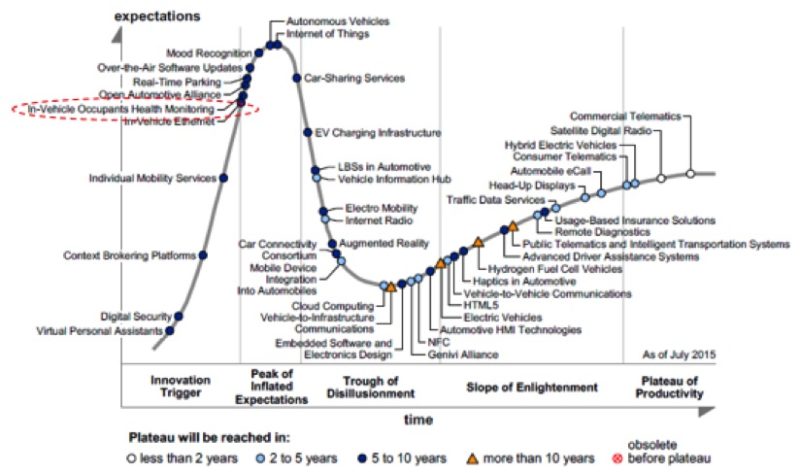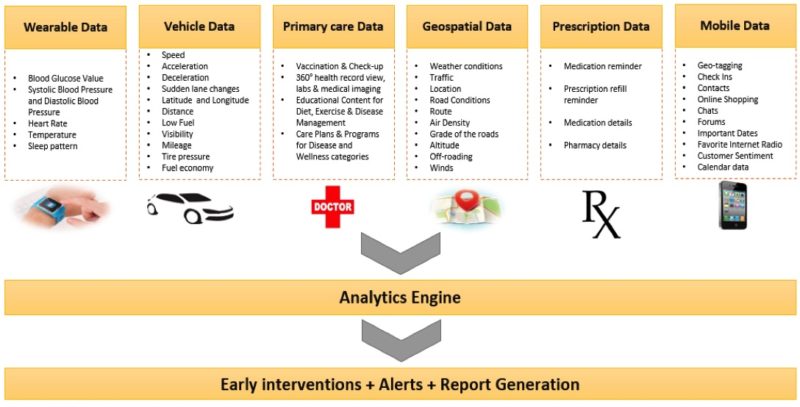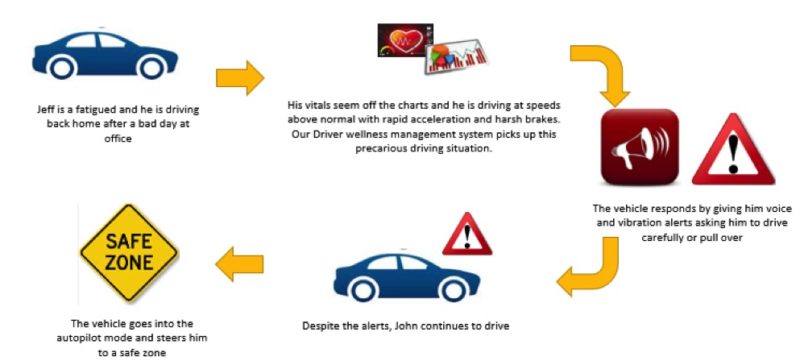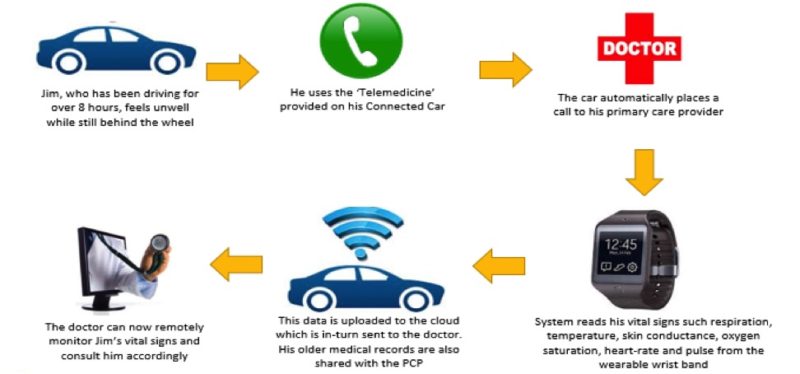
Chronic illnesses are on the rise, and according to a recent study, almost 45% of adults in the US are dealing with at least one chronic condition like Blood Pressure or diabetes. But with rapid advancements in wearable technology, people have started taking a more proactive approach to health. This is reflected in increased adoption of ‘Connected’ health devices and wearables used for real-time health monitoring. Smart watches and smart bands in the ‘Health and Fitness’ segment are now among the fastest growing categories of wearables.
Time spent by an average person in daily commute has also gone up over the years. Data collected by AAA Foundation indicates that, on an average, drivers in the US made two driving trips per day (for 46 minutes) which translates to 29.2 miles per day or 10,658 miles annually. National Highway Traffic Safety Administration (NHTSA) has conducted a study that identifies certain medical conditions that contribute to motor vehicle crash causation. It was found that about 1.3% of all crashes included in this survey were caused by driver reported medical emergencies and 84% of the drivers in these emergencies experienced seizures, blackouts or diabetic reaction prior to the crashes. Thus, there is a strong premise for monitoring the health status of drivers through active or passive methods.
Convergence of innovation, IoT, Connected Vehicle Technology, Healthcare and miniaturization is expected to give rise to several unique business models that give people a holistic view of their healthcare needs. This opens up multiple avenues for Automotive OEMs to collaborate with technology companies, healthcare providers & medical devices industry. Several automakers have started looking at integrating aspects of Healthcare with driving to enhance customer experience.
This white paper explores the evolution, impact and benefits of In-vehicle Occupant Health monitoring. We look at industry examples, solution considerations and scenarios where information from healthcare wearables enhance the safety of vehicle occupants. We also analyze the challenges and present our point-of-view on how maximum value can be derived through this concept.
A Closer Look at Driver Health Monitoring
Collecting vital health parameters of the driver and combining them with physiological, clinical, spatial and vehicle information may lead to timely interventions which would reduce chances of medical mishaps behind the wheel and in turn increase safety and comfort of driving. Many a times, accidents are caused due to tiredness, ill-health and distraction of drivers. In-vehicle sensors & driver’s wearable devices enhance safety of driving by extending driver’s ability to monitor vital health parameters and take action in case of an emergency.
Driver health monitoring or In-vehicle health monitoring systems refer to sensors and algorithms that can measure the biophysical attributes of drivers and other vehicle occupants. This can be achieved either through sensors embedded in vehicles or through wearable devices. Several valuable insights can be derived by combining the vehicle data with the health data. For example, a low blood sugar level could be detected by a vehicle and used to prevent a potential car accident. In case of a medical emergency, the vehicle could automatically notify emergency crews or nearby drivers, and alert the family members to the emergency.
Consider a scenario where the driver is unwell and uneasy behind the wheel. His vitals like heart rate, BP and temperature are high. He is fatigued and unable to concentrate behind the wheel and as a consequence he is rapidly accelerating/decelerating and performing sudden lane changes. The Driver Health monitoring system is able to correlate these and predict that the driver is stressed out and take appropriate action.
Health monitoring inside the car can contribute to safety enhancements as well as to the overall wellness of the driver. There are no market-ready solutions are available today, but several automakers are collaborating with technology companies, academia and healthcare device manufacturers to deploy specific Use Cases.
Business Impact For Automakers
Gartner hype cycles for ‘Connected Vehicles and smart mobility’ (Figure 1) as well as ‘Consumer Engagement with Healthcare and Wellness’ have placed ‘In-Vehicle Occupants Health Monitoring’ at the ‘Peak of Inflated Expectations’.
In-vehicle health monitoring can expand the functionality and value proposition of an automaker’s products. Healthcare delivery organizations can leverage the biometric data for identifying members’ health issues early on, and can prepare for treatment options.

Detecting any variation in vital signs or chronic medical conditions will help in taking the right corrective action, such as taking medication, informing care provider, alerting the family or trigger an active safety measure, such as, stopping the car. Driver monitoring systems can be highly beneficial to the automotive consumer as it will add another layer of safety to their Connected Car.
OEM Initiatives in Driver Health Monitoring
Automakers such as Audi, BMW, Mercedes, Ford, Volkswagen and Volvo already offer features for monitoring driver attention and detect drowsiness using driving inputs cameras and sensors. In precarious conditions, these built-in systems can alert the user and in some cases take remedial action. Attention assistance systems are slowly becoming mainstream now with several more OEMs announcing their plans to roll-out similar systems.
OEMs like Ford, BMW, and Toyota are already experimenting with incorporating medical sensors within the car that would monitor the driver’s vitals and could potentially allow doctors to even examine people remotely.
BMW and Munich Technical University are working on a steering wheel capable of detecting a driver’s pulse, oxygen saturation and perspiration. This can give driver a quick health-check while on the wheel.
A few OEMs are also working on facial recognition technology. French automaker Peugeot is collaborating with researchers to create a video sensor can monitor faces to detect driver emotions. Researchers at MIT are also working on Project ‘Autoemotive’ that is exploring implementation of mood-recognition technology in cars.
Toyota began experimenting a few years ago with a system that monitors cardiovascular functions via the driver’s grip on the steering wheel, although that system remains a prototype.
Ford has a patent on technology to monitor drivers’ changing health behind the wheel and potentially share that information with their healthcare provider. Ford Germany and Aachen University worked on the Ford heart monitor seat that has special embedded sensors that detect electrical impulses generated by the heart. If the seat detects a heart problem and or camera detects slumping, the system engages safety measures if heart attack occurs, the vehicle’s self-driving module kicks in to stop in a safe location and avoid an imminent collision. It could also be programmed to e-call for help.
Integrated Driver Wellness Management: An Approach
A plausible approach to Driver Health monitoring is integration of data from various sources like the driver’s wearable devices, primary care information, prescription details along with vehicle information, environmental/geospatial data and mobile data to facilitate holistic wellness management for the driver through prescriptive, predictive and preventive alerts/interventions. Health/fitness wearable devices of the driver can unlock a wealth of information and vital health parameters. Real-time data on heart-rate, blood pressure, skin conductance etc. can be obtained even through the most basic wearables. These, when combined with driver’s primary care information and prescription details can give a holistic picture of the driver’s healthcare requirements.
The system should capture health profile and preferences of the driver; and must have a robust authentication mechanism for logging in. The concept of BYOD can be extended to this context – the data from driver’s health/fitness wearable can be utilized in combination with data from other sources to tailor interventions. Irrespective of the wearable device used, the system should be able to authenticate the user and immediately obtain access to the driver’s health data, preference and primary care information. This would ensure a high degree of personalization and better user experience.
Real-time vehicle data can be obtained from vehicle sensors through an OBD
reader/scanner. Data on speed, acceleration, braking, steering wheel etc. can be correlated to give an insight into the driving pattern of a particular driver. These, when combined with the driver’s health information, can potentially identify precarious driving situations linked to driver’s health. The system will in turn trigger an alert or an active safety measure which could possibly even save the driver’s life.
Environmental, mobile and geo-spatial data can also be correlated to the driver health monitoring. Information on weather conditions, traffic, road conditions, routes, air density, altitude, pollution levels etc. could be used in several scenarios in this context.
When a combination of inputs leads to a pattern discovery, the car can take some remedial action or generate alerts or early interventions. Some of the outcomes could be:
• Giving voice/vibration alerts warning the driver to drive carefully
• Alerting the family to the condition and helping them navigate to the location of the car
• Altering in-car parameters such as temperature, seating position, playlists etc.
• Active safety measures, such as, stopping the car
• Informing primary care provider or care coordinator of medical condition, book appointments
• Giving a medication reminder, prescription refill alert
• Blocking voice calls with a callback message
This approach to integrated Driver wellness management has been depicted in Figure 2.

Inputs to the Integrated Driver Wellness Management system can be either a single source or multiple sources. The data from these sources is parsed, cleansed and passed through the rules engine that would in turn derive patterns that would trigger actions. Output from the system could be as basic as giving sound/vibration alerts to calling emergency service or even self-steering the car to safety. When used in combination with, ADAS features, Driver Health monitoring can give rise to several high-impact use-case scenarios. (Figure 3)

There are several factors that need to be taken into consideration while designing a solution for Driver Health monitoring. System should be designed in such a way that false positives and alerts are filtered out. Monitoring should be done in the least distracting and least invasive manner. At no point of time should the comfort and safety of the driver be compromised. It is also important that in-car health monitoring be an opt-in solution, rather than mandatory.
Value Creation Opportunities For Automakers
The collective computing power and data from all these interconnected elements can be harnessed to create many compelling Use Cases. Driver Health monitoring presents a gamut of benefits and opportunities for all the stakeholders involved.
For the automotive consumer, in-car health monitoring will provide an enhanced experience by improving the safety and comfort aspects. This would empower them by letting them take a greater control of their health. Healthcare delivery organizations can leverage this to identify members’ Health issues early on and prepare treatment options. The detailed stakeholder-benefit mapping has been depicted in Table 1.
| Stakeholder | Benefit |
| Automotive consumer |
|
| Automakers/OEMs |
|
| Healthcare providers |
|
Table 1: Stakeholder benefit mapping for driver health monitoring
Today, more than half of hospitals in the US use telemedicine – exchange of medical information from one site to another via electronic communication – to engage with patients remotely and do everything from monitoring vital signs to full-fledged consultations. In-car health monitoring can help a driver in need of medical assistance by sharing medically vital parameters from his wearable to a healthcare provider. A scenario for telemedicine has been depicted in Figure 4.

This concept can be extended to other long distance modes of travel too and is especially beneficial to the Transportation & Logistics industry.
Challenges & Risks
While there are immense benefits of Driver Health monitoring, there are also a few challenges that need to be addressed in order for the concept to see widespread adoption. A few of them have been discussed in this section.
Regulatory Compliance
The HIPAA (Health Insurance Portability and Accountability Act of 1996) has set rights for an individual’s Health information over who can review and receive this data. Driver Health monitoring involves collection and analysis of driver’s personal and health information which might be in line with the data protection norms specified by HIPAA. It is likely an interpretation of HIPAA in the vehicle environment may need further review as this technology develops. In-vehicle medical advice in-car may also need FDA approvals.
In-car use of specific types of wearables (especially eye-wear), is also controversial with some governments dismissing them as they are perceived to cause a distraction to the driver. It should be taken care that the Use Cases considered for development contribute to safer driving, and do not deter it.
Data Protection & Privacy Concerns
Security is another major concern and the data that is being collected can be subject to misuse. Consumer privacy concerns need to be addressed as there is a possibility of cybersecurity attacks and misuse of private information. Organizations should put safeguards in place and ensure the health and driver data, as well as the cloud layer, is protected from mischievous intent and malicious attacks.
It is also important that the monitoring is done only with the opt-in of the driver or the vehicle occupants. At any given point, the driver should be allowed to cancel the data send or opt-out of real-time monitoring.
Infrastructure Challenges
IoT solutions involve a large number of always-on devices that are constantly generating data. Organizations should put in place, a robust infrastructure with adequate security measures to deal with large volumes of data. They should invest in building capabilities in areas like cloud computing, big data analytics, new data integration approaches and collaborate with vendors with proven capabilities that can consult, implement, validate and monitor solutions for them.
Way Forward
In-car occupant health monitoring, as a concept, has immense potential and can elevate driving experience by enhancing the comfort and safety of the driver. Automotive companies should collaborate with Technology companies, Consumer Healthcare manufacturers and Medical system to explore Use Cases in this area. They should work on assessment, evaluation and deployment of select ‘Proofs of Concept’ as a next step. Based on the feedback and data collected, further iterative feature enhancements need to be made.
In an industry where are products are increasingly being perceived as similar, it is important that automakers invest in IoT and related technologies that bring about differentiation and give products a competitive edge. Automakers must carefully balance the features with the challenges and come up with a viable solution for widespread acceptance.







